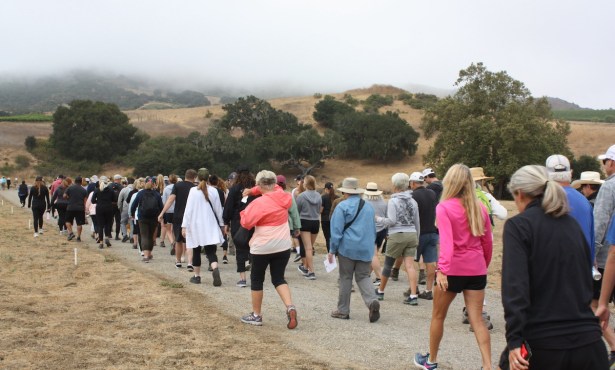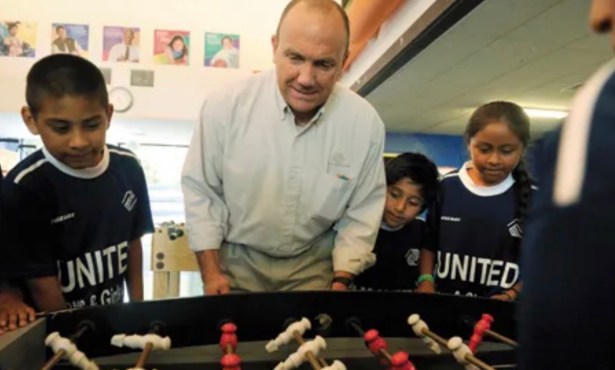Design Submissions Are Open for Santa Barbara Botanic Garden’s Backcountry Casitas
Natural Playhouses Encourage Exploration

Children’s unceasing laughter echoes throughout Santa Barbara Botanic Garden’s Backcountry as they run around obstacles, discover animals hidden under wet logs, and explore the Casitas — the Backcountry’s natural playhouses.
Sitting on 78 acres, the Santa Barbara Botanic Garden is home to various native plants and habitats. The garden’s mission is to preserve those native species and simultaneously educate the community about the natural world. Guests can walk along carved trails, explore 11 different California ecosystems, and learn about the unique plants that inhabit each section. But, it’s the Backcountry where exploration reaches new heights and encourages explorers to take the path less traveled.
“The Backcountry is a space that is all about free exploration in the natural world,” said Scot Pipkin, director of education and engagement at Santa Barbara Botanic Garden. The Backcountry encourages kids to ditch their screens and explore nature freely and, most importantly, of their own volition. There is no “right way” to explore the Backcountry. “We’ve designed it to invite a lot of choice in how people move through the space,” said Pipkin.
Dotted amid the vast expanse of the garden’s Backcountry, the Casitas serve as both enduring fixtures and transient waystations along the paths of exploration. In 2019, the Casitas were introduced to the garden with six temporary playhouses and even predate the creation of the Backcountry area itself, which was introduced in 2022. These captivating structures temporarily grace the landscape for six months to two years before being replaced by new installations. Submissions for this year’s competition are open, and everyone is encouraged to apply. The entry deadline is Friday, December 15, and each winner will receive a $5,000 stipend to construct their designs. The 2024 winners will be announced in January and will replace three of the five playhouses.
“I’ve just been overwhelmed over the last couple of years by the creativity and ingenuity that the folks who have submitted designs display,” said Pipkin.
Pipkin gave me a tour of the garden’s Backcountry. We walked through a grove of redwood trees that resembled paintbrushes touching the sky, and when we transitioned into the Backcountry section of the garden, the tidy road broke off into one large area. This transition is intentional — guests take charge of their navigation and allow creativity to lead the way. Pipkin encouraged this idea as we traversed boulders, jumped on stumps, and maintained our balance while crossing a tree trunk — I felt like a kid again.
We emerged on the opposite side and stumbled upon the “Troll Trolling Trees” — a Casita designed by Natalie Leyva that resembles a troll. Pipkin is always thinking of new ways to enhance children’s experience in the Backcountry. One idea he mentioned was placing a sign at the entrance encouraging the kids to find a different way to the troll. “What we want is to connect people to nature,” he said. “And it’s not easy to immerse oneself in a natural setting,” he continued.

Construction of a Casita usually takes a few weeks. “We encourage natural materials as much as possible,” said Pipkin. In the past, some Casitas have used dimensional lumber, but in that case, they encourage it to be from native plants like redwood. The replaced Casitas may be rehomed or broken down with the materials being reused for future projects. Montecito Union School District houses one of the first Casitas — “The Hives” — designed by the garden’s Executive Director Steve Windhager, PhD. And, for Cody Westheimer’s “Hawk’s Nest,” Douglas fir poles were reused from one of the first 2019 Casitas, “The Understory” by Akiko Wade Davis, AIA Wade Davis Design, and John Lambe Construction. “We try to find life after the garden for these Casitas,” said Pipkin.
The Casitas fall into a couple of categories, Pipkin said. Some are imaginary, like “The Gaya Tree,” while others are contemplative, like “Hawk’s Nest,” and some are more active designs involving ropes and tunnels. “We want to have a good balance of all the activities,” said Pipkin. But that doesn’t mean that every design falls into these categories. Pipkin encourages designers to unleash their creativity.
The Backcountry isn’t a playground but a gateway to the unexplored natural world. The Backcountry is a catalyst for innovative education, aiming to acquaint children with nature and foster an appreciation for its role, particularly in light of climate change. Pipkin is constantly imagining new ways to weave education into the gardens, hopeful that future generations will develop deep relationships with nature or get involved with conservation.
Near the garden’s entrance, the sequoia-tree wood round illustrates how the garden can impart knowledge about climate change to visitors. As Pipkin traces the growth rings on the round, he explains that rings with shorter gaps signify a dry year, while those with larger gaps indicate a wet year. “I really want this to be more about climate change because we need to be thinking about it,” said Pipkin. The sequoia-tree round is just one example of climate change education in the gardens.
While standing on a bridge that connected the Backcountry to the main gardens overlooking the creek, I observed Pipkin actively brainstorming. On one end of the bridge is a perfectly paved road, and on the other is a dirt path. Pipkin tells me how he’s looking for ways to create a smooth transition between the two spaces. “How do we really activate you at this spot where we have the opportunity to ignite the wonder and encourage that exploration?” said Pipkin. It’s all about trial and error, weaving out what doesn’t work with what does — that’s how the best innovative ideas come to fruition. “You turn the knob a little bit, and see what happens.”
The Garden is hosting a pre-entry Zoom meeting on Thursday, November 16, at 4 p.m. To register, and for design criteria and submission information, please visit sbbotanicgarden.org/explore/sections/backcountry/backcountry-casitas-program.
For more information about the Casitas, visit sbbotanicgarden.org/press/winning-designs-announced-for-2022-backcountry-casitas-at-santa-barbara-botanic-garden/.




You must be logged in to post a comment.